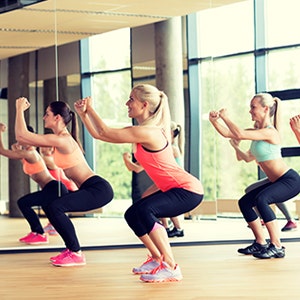HIIT: What it is, what it’s NOT and 5 reasons to care

High Intensity Interval Training (HIIT) programs have exploded in popularity in recent years. In fact, the American College of Sports Medicine identified HIIT as one of the top fitness trends. This style of program uses short periods of intense work to give you one of the most efficient workouts you can find. Here’s what you need to know to decide if it’s a format for you – and how to get started.
WHAT IT IS
As a researcher at Japan’s National Institute for Health and Nutrition in the ‘90s, Dr. Izumi Tabata found that brief, high-intensity exercise intervals followed by short rest intervals were effective for improving the body’s ability to use oxygen, and for increasing caloric burn. The Tabata Training protocol combined 20-second work intervals of very high intensity with 10-second rest intervals, repeated eight times for a total of four minutes of exercise time.
More recently, Dr. Martin Gibala, a Canadian researcher, has been studying the benefits of HIIT for weight loss. Dr. Gibala has found that alternating intervals of high- and low-intensity exercise can be part of a weight-loss program for just about any fitness level – because you define the intensity. For experienced exercisers, high-intensity may mean a full-on sprint, while beginners may consider walking at a faster pace as high-intensity exercise.
Exercise intensity is measured using a rate of perceived exertion (RPE), where 1 is low intensity and 10 is the most you can tolerate. HIIT should be performed at an RPE of 8 or higher for work intervals lasting 30 seconds or less – whenever you reach the point of breathlessness. Recovery intervals should last at least as long as the work interval, or until your breathing is under control.
WHAT IT ISN’T
HIIT can put a tremendous amount of stress on the body, so it should only be done two or three times a week, with at least 48 hours of recovery between sessions. If you’d like to exercise the day after a HIIT session, try a complementary style of training that uses different muscle groups, movement patterns, and lower intensity.
Also, HIIT is not weight-loss magic. Any exercise program is going to need backup from a solid nutrition plan. Don’t have one? Ask one of our health and fitness professionals next time you’re in the gym. They love it when people ask them about nutrition.
FOUR REASONS TO CARE
- HIIT causes the metabolism to remain elevated and continue burning calories for hours after the workout is over. This is called excess post-exercise oxygen consumption (EPOC), and you’ll deserve it.
2. Heart health: HIIT can reduce your resting heart rate, by increasing the amount of blood pumped per heartbeat. Resting heart rate is one of the key indicators of cardiovascular health and longevity.
3. HIIT puts a significant amount of stress on involved muscle tissue. As part of the repair process, the body produces anabolic hormones – chemicals that play a critical role in metabolism and increase lean muscle mass and encourage fat metabolism.
4. Less time in the gym means more time to enjoy the healthy life you’re working so hard for.
Want to get started on HIIT at 24 Hour Fitness?
- Great interval workouts on our first-class equipment.
- Dynamic Group X classes that take advantage of HIIT protocols.
- Health and fitness professionals who can design HIIT sessions just for you.
A QUICK HIIT
Here’s an example of a HIIT workout.
• Walk or jog on a treadmill for five minutes to warm up your body with mobility exercises so you have freedom of movement.
• Begin your first work interval with a 30-second, fast walk/run/sprint at an RPE of 8.
• Then rest for 30 seconds.
• Repeat the work and rest intervals at least five times (to a maximum of 10 times).
• Spend another five minutes walking to cool down.
Total workout time is 15-20 minutes depending on the number of intervals. Interested yet?
THE SOFTER SIDE OF HIIT
It’s important to take care of yourself before and after HIIT workouts, or you’ll burn out – or risk injury.
• Warm up. Be sure to do full-body, low- to moderate- intensity exercise until you break a sweat.
• Drink up. Stay hydrated during the workout, and refuel with a recovery drink within 30-40 minutes after the workout.
• Let your body recover. Your workout the next day should be low-moderate intensity using dif-ferent muscles or another mode of exercise, such as yoga.
• Move gently. If you’re sore, light exercise for at least 20 minutes will elevate heart rate, remove metabolic waste from your muscles and promote recovery.